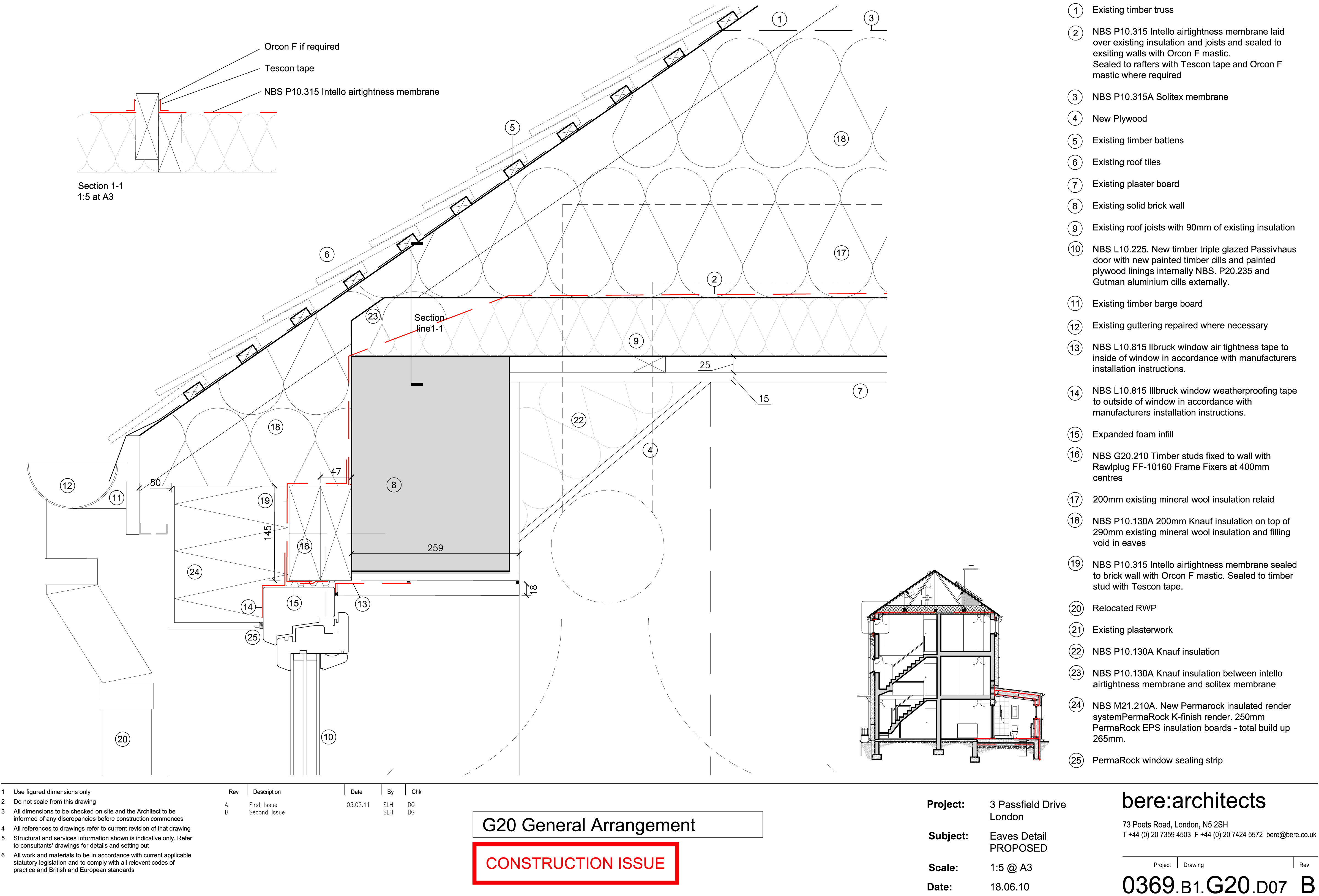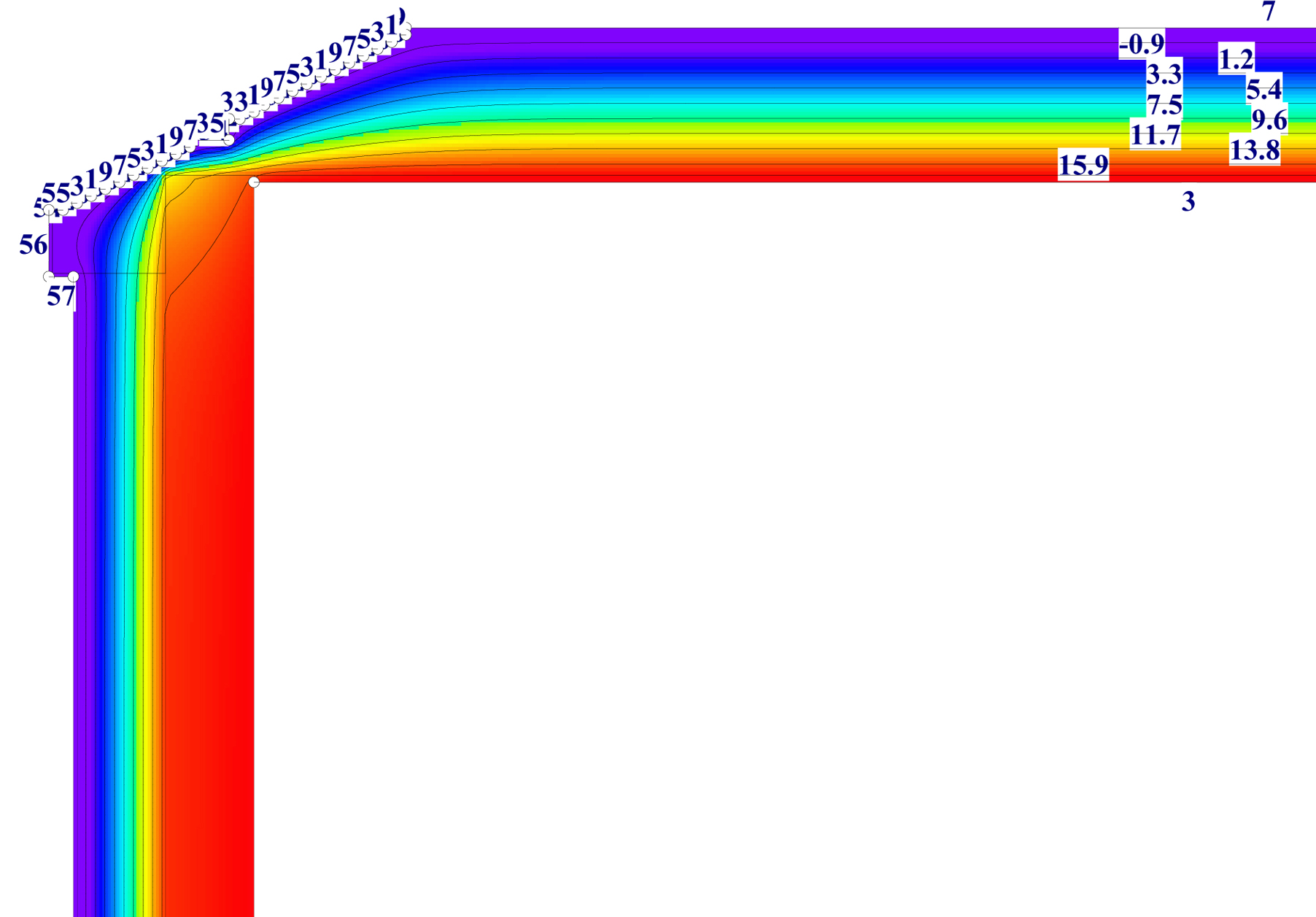Last Tuesday morning we visited our ‘towards Passivhaus’ Retrofit-for-the-Future project at 3 Passfield Drive in East London to take some thermal images of the finished retrofit. We wanted to take advantage of the cold snap that is being experienced across the country to check the thermal performance of the building.
At 8.30am on Tuesday morning the outside temperature was 1.5°C. The thermal images of the front facades of Passfield Drive, shown above in Fig 1, are a powerful visual indication of just how much energy this retrofit is saving.
In the above thermal image, 3 Passfield Drive is three houses from the left end of the terrace and is clearly emitting far less heat to the atmosphere than the other buildings in the terrace. Our thermal imaging equipment enables us to read surface temperatures. The temperatures shown in the above image are the external surface temperatures at the points indicated. Six temperatures are shown on the image:
· The triple glazed Passivhaus windows of the passivhaus retrofit (minus) -0.9°C
· The external face of the insulated façade of the passivhaus retrofit (minus) -2.3°C
· A hot spot on the façade of an unimproved neighbour (No. 4) +9.0°C
· The double glazing of an unimproved neighbour (No. 4) +2.2°C.
· The un-insulated façade of No.5 +1.1°C
· The temperature of the wall near an exhaust vent at No. 6 +11.0°C
The 3.4°C temperature difference at the beginning of the day, between the façade of No.3 and No.4 demonstrates how well the 250mm of polystyrene external insulation is performing and how much more heat is being retained inside the retrofit because of it. Similarly we can see that the Passivhaus triple glazed windows installed to No.3 have excellent thermal performance and are retaining significantly more heat than the double glazing at No.4.
It would also be interesting to measure the temperatures in the evening to see if the temperature differences vary at the end of the heating day, compared to the start of the heating day.
Although the images demonstrate the great benefits of a passivhaus retrofit, pictures taken inside the top floor indicate the problems that mainly result from a change to the design that was requested by the occupants who did not like the fillet of insulation that we had proposed behind the eaves of the roof.
The image below (Fig 2) is an internal image in the rear bedroom on the top floor of the house. These worrying cold bands along the top of the wall next to the loft are the result of leaving out the internal fillet of insulation (see drawing below). Over a distance of less than a metre, the wall temperature drops from over 17 degrees centigrade to just over 12 degrees. This is far from ideal and leaves a risk of condensation and mould growth which can undermine the improved warmth and healthy conditions created for the occupants by the rest of the retrofit.

Fig 2. Cold bands across the top of the external wall in the rear bedroom on the 31st of Jan 2012.
bere:architects had intended for a fillet of insulation to be installed on the internal side of the junction (see figure 3) but this was left out due to the wishes of the building occupant. Our thermal images illustrate why it would have been beneficial to retain the fillet of insulation. Now that the occupants understand how even a small cold bridge can affect their thermal comfort, the residents want the fillet put in, but the contract works have finished and it may not be possible to find funding to do the intended work at this late stage.

Fig.3 Original detail produced by bere:architects showing internal fillet of insulation.
bere:architects have undertaken thermal analysis to compare the performance of the junction with and without the fillet of insulation. Our analysis demonstrates that even without the fillet of internal insulation the surface temperature of the internal wall would not be expected to be as low as figure 2 demonstrates it to be. Figure 4 demonstrates the junction with an internal fillet of insulation and figure 5 demonstrates the same junction with the fillet omitted. In Figure 5 the surface temperature of the wall is not significantly lower than the surface temperature of the wall in Figure 4. However if we model the junction using the internal temperature on the day we took the thermal image (31st of January) and model the external temperature as it would have been during the night before we can see that the surface temperature of the wall would be significantly lower. Figure .6 demonstrates this. Here the internal temperature is 18°C and external temperature is -3°C. However the internal surface temperature of the wall is still not as low as 12.8°C (the temperature that was recorded by the thermal image camera on the 31st of January). This shows that the omission of the internal fillet of insulation alone would not be a cause for concern.
[[{"type":"media","view_mode":"media_original","fid":"2503","attributes":{"class":"media-image","height":"369","id":"2","style":"width: 530px; height: 369px; ;;;;;;;;;;;;;;;;","typeof":"foaf:Image","width":"530"}}]]
Fig 4. Thermal analysis of original detail with fillet of insulation. Surface temperature of internal wall is approximately 20°C


Fig 6. Thermal analysis of original detail with fillet omitted. Temperatures modelled as on night of the 30th of January. Internal temperature 18°C and external temperature -3°C. Surface temperature of internal wall is approximately 16°C.
The foundations at 3 Passfield Drive have had external insulation applied to a depth of 1m below ground level, so there is no significant heat loss. However there is a significant amount of heat leaking through the foundations of the adjacent houses (right hand side of Fig 4). The heat is leaching across the front of the retrofitted building but reduces out of view to the left of the picture, further away from the neighbouring house which is the source of the problem.
[[{"type":"media","view_mode":"media_large","fid":"2399","attributes":{"class":"media-image","id":"1","typeof":"foaf:Image"}}]]
Fig 3. The un-insulated house (right) is losing a substantial amount of heat through its ground floor

Fig 4. Turning to the left, the effect of the neighbour's ground slab heat losses diminishes
In spite of the defective insulation on the top floor, Mr Muhammad tells us that the house is much warmer after the retrofit than before, and more comfortable, and much cheaper to heat. Before the retrofit, the family could not sit for long on the ground floor in the winter months because of the cold temperatures and draughts. Now the family has much higher indoor temperatures and at the same time winter fuel bills have halved. We will shortly be producing a full report of the fuel cost savings.
Mr Muhammad spoke of how in winter, prior to the retrofit, it would take two hours for the house to warm up in the mornings. Now with his wife and son’s family away visiting their sick grandmother, he needs to put the heating on for ten minutes every couple days. When his wife and family are home, the heat from the cooking itself is usually enough to heat the house.
Even with the defects that we have highlighted the building is performing very well while many of the neighbours will be using a lot more heat in their struggle to keep warm during the cold weather.
Un-insulated houses are problematic for the following reasons:
· Unchecked fuel poverty is inhumane and affects the health of vulnerable people, especially the elderly.
· Illness caused by cold homes costs the Health Service large sums of money.
· Money wasted in heating houses goes overseas, draining the national economy.
There is clearly a political opportunity to spend some money now in order to save money in the longer run. In a time of austerity, this is a very significant opportunity to save the economy while saving jobs and saving money.
However well-intentioned the ‘Green Deal’ is, it is insufficient to achieve the benefits referred to above because small, cheap improvements on individual buildings are much more costly per kilowatt of energy saved, than a properly planned long-term ‘roll out’. It will be much more effective, and cheaper, to implement a properly organised and efficient ‘roll-out’ scheme doing a whole terrace or street of houses at a time.
But such a scheme will need to start gradually, and grow as skills grow. Insufficient architects have the skills needed to manage this work effectively, and there is a shortage of skilled, diligent contractors, so a series of large demonstration projects should be rolled out to build skills in both architects and the building trades.
Sadly, what seems obvious to all the experts just doesn’t seem to be understood by the short-sited people in the silo that is called the UK Treasury. Maybe the poor Treasury ministers are just surrounded by the wrong people? I listened to a housing industry lobbyist in a seminar in Cambridge a couple of years ago boasting how he was about to take up a position in the Treasury. There are huge financial rewards for industry if it infiltrates government and the civil service. But why aren’t there effective safeguards to stop this happening?
True expert leadership is needed in the UK, not government pandering to the self-rewarding vested interests.